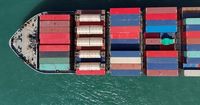In a dramatic escalation of the ongoing battle over U.S. trade policy, the Trump administration has asked the Supreme Court to swiftly decide whether the president has the authority to impose sweeping tariffs—an issue that could reshape the balance of power between the executive and legislative branches and reverberate through the global economy. The move comes after a federal appeals court ruled that President Donald Trump exceeded his legal powers in enacting a series of tariffs central to his economic and foreign policy agenda, setting up a legal showdown with high stakes for businesses, international partners, and the federal government itself.
On September 3, 2025, the administration filed its petition electronically, urging the justices to take up the case without delay and hear arguments as early as November. According to Reuters, the Justice Department specifically called for a decision on whether to accept the case by September 10, with the Supreme Court’s new term beginning October 6. Solicitor General D. John Sauer, representing the administration, warned in his filing that the lower court’s decision “casts a pall of uncertainty upon ongoing foreign negotiations that the President has been pursuing through tariffs over the past five months, jeopardizing both already negotiated framework deals and ongoing negotiations.”
The tariffs at the heart of the dispute were imposed in April and February 2025, targeting imports from more than 90 countries, including Canada, China, and Mexico. Trump declared an economic emergency, citing a longstanding U.S. trade deficit, threats to domestic manufacturing, and national security concerns. He justified the measures under the 1977 International Emergency Economic Powers Act (IEEPA), a law historically used for imposing sanctions or freezing assets, not for levying tariffs. The administration argued that the economic threats posed by trade imbalances and illicit drug trafficking—particularly fentanyl—necessitated immediate and forceful action.
But the U.S. Court of Appeals for the Federal Circuit, in a 7–4 decision on August 29, found that Trump’s use of IEEPA to impose tariffs was an illegal overreach. The court wrote, “It seems unlikely that Congress intended, in enacting IEEPA, to depart from its past practice and grant the President unlimited authority to impose tariffs.” The majority opinion emphasized that setting tariffs is a “core Congressional power,” and the law’s emergency provisions were never meant to hand the president such sweeping authority. The court also invoked the Supreme Court’s “major questions” doctrine, which requires Congress to clearly authorize executive actions of vast economic and political significance.
Despite the ruling, the tariffs remain in effect for now. The appellate court postponed the decision’s implementation to allow the administration time to appeal. If the Supreme Court declines to take up the case, the ruling could take effect as soon as October 14, potentially forcing the government to refund billions of dollars in tariffs collected since the measures were imposed. According to the Associated Press, revenue from the tariffs had reached $159 billion by late August—more than double the amount collected at the same point the previous year.
The administration’s argument for Supreme Court intervention is urgent and sweeping. Solicitor General Sauer contended that the tariffs are “promoting peace and unprecedented economic prosperity,” and warned that denying tariff authority “would expose our nation to trade retaliation without effective defenses and thrust America back to the brink of economic catastrophe.” Treasury Secretary Scott Bessent, in a declaration filed with the appeal, argued that the lower court’s decision undermines the president’s ability to “conduct real-world diplomacy and his ability to protect the national security and economy of the United States.”
Yet the stakes are just as high for the small businesses and states challenging the tariffs. Many have argued that the sudden imposition of import duties—sometimes with little warning—has disrupted supply chains, raised costs, and threatened their very survival. Jeffrey Schwab, senior counsel at the Liberty Justice Center and a lawyer for several small business plaintiffs, told BBC, “These unlawful tariffs are inflicting serious harm on small businesses and jeopardizing their survival. We hope for a prompt resolution of this case for our clients.” The lawsuits, brought by importers ranging from a New York wine and spirits company to a Pennsylvania sport fishing retailer, have been joined by a coalition of 12 states, most governed by Democrats, who argue that the president’s actions violate the Constitution’s separation of powers.
The legal wrangling has broader implications for Trump’s economic agenda and the future of U.S. trade policy. While the current dispute centers on the use of IEEPA, Politico notes that there are at least five other statutes a president could invoke to impose tariffs, some of which have never been tested in court. These include the infamous Smoot-Hawley Tariff Act, which allows for tariffs up to 50% on imports from countries that "discriminate" against the U.S.; laws signed by Presidents Kennedy and Ford that permit tariffs if imports threaten national security or domestic industries; and statutes allowing temporary surcharges to address balance-of-payments deficits. The United States Trade Representative also retains authority to enforce trade agreement rights with presidential coordination. Congress, for its part, has the power to undo presidential tariffs, though past efforts have stalled or failed in the House.
Notably, some of Trump’s tariffs—such as those on steel, aluminum, and autos—were imposed under different legal authorities and are not affected by the current appeals court ruling. The litigation also does not touch the tariffs on China that were maintained by President Joe Biden during his term. Nonetheless, the outcome of this Supreme Court case could set a powerful precedent, either reaffirming the president’s broad discretion in trade matters or reining in executive power and restoring Congressional oversight.
For now, the legal and political uncertainty continues to ripple through global markets. Trump has wielded tariffs as a tool of both economic leverage and diplomatic pressure, using them to renegotiate trade deals and extract concessions from international partners. Critics argue that the trade war has alienated key allies, increased volatility in financial markets, and fueled global economic instability. Supporters, however, insist that aggressive tariff policy is necessary to protect American jobs, industries, and security interests in an increasingly competitive world.
As the Supreme Court prepares to consider the case, the nation—and the world—waits for clarity on just how much power the president holds over the levers of international commerce. The answer could reshape not just the U.S. economy, but the very structure of American government for years to come.


